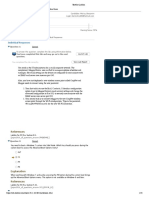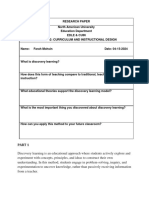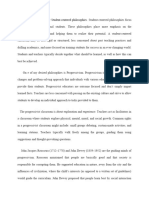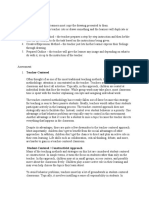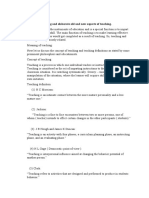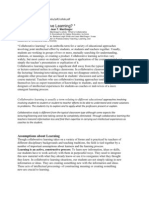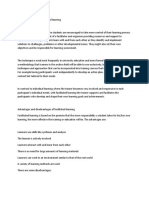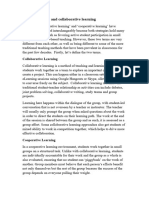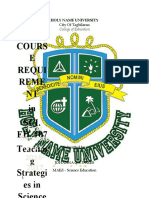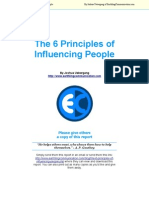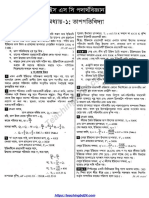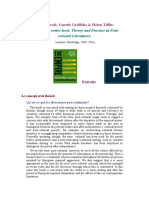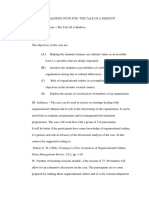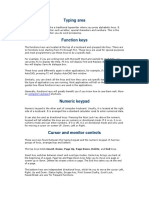Emerging Approaches and Methodologies
Emerging Approaches and Methodologies
Uploaded by
Buried_ChildCopyright:
Available Formats
Emerging Approaches and Methodologies
Emerging Approaches and Methodologies
Uploaded by
Buried_ChildCopyright
Available Formats
Share this document
Did you find this document useful?
Is this content inappropriate?
Copyright:
Available Formats
Emerging Approaches and Methodologies
Emerging Approaches and Methodologies
Uploaded by
Buried_ChildCopyright:
Available Formats
Emerging Approaches and Methodologies in Teaching In education, nothing is constant.
What might have been status quo a generation ago in educational circles may already be superseded today. New approaches may come to supplement already existing approaches. New insights about the nature of knowledge emerge every now and then. Here, we will cover four emerging approaches and methodologies in the field of teaching. The first one is constructivism. Constructivism is a learning theory that presupposes that students knowledge is not imposed from without by teachers but made by the students themselves. This learning theory gives way for more active learning in the part of the student as opposed to passive learning. We will discuss how to make constructivism effective in the classroom. The next approach is cooperative learning. Cooperative learning involves learning in groups rather than as individuals who compete or are isolated. We will discuss the benefits of cooperative learning, common approaches to cooperative learning, and different ways to carry it out in the classroom effectively. Then we will proceed to the investigative method, which involves examination of real-life or contrived cases in different fields of endeavour like Science, Social Studies, etc. We will discuss the common steps applicable in the investigative method. Then we will end with problem-solving method, which imparts problem-solving skills relevant in the world today. We will also discuss the attitudes of successful problem-solvers, metacognitive skills, and problem solving in the classroom. Constructivism In constructivism, there is no direct transmission of knowledge from teacher to learner. Students construct knowledge; they do not merely record understanding. In a classroom that follows the constructivist approach, students' learning should be active rather than passive. Passive learning manifests itself in many common forms. Listening to teachers' lectures, answering convergent questions (questions that lead to established answers), and drill and application regarding information that the student has received. Note that all of these passive learning approaches focus on the information given by the teacher. Active learning, however, includes the following: investigative work, work involving small groups, learning by experience, cooperative learning, and problem solving. Look at the difference. In passive learning, the focus is on the teacher - teacher lectures and students listen; teacher asks and student answers (and if student is wrong then in some way he gets corrected); teacher drills and students show whether they have reached enough to accomplish the teacher's standards. In active learning, the students do the investigation; the students cooperate; the students grapple with problems; and so on. That is not to say that the teacher vanishes from the classroom; rather, she turns to being a "guide on the side" instead of being a "sage on the stage". That is not also to say that information is unimportant in
constructivist learning theory; what is different in constructivism is how students assimilate information. Far from the familiar conception that teacher should "fill" students with "buckets" of information, students are naturally curious and want to see how the world works along with that it means. Information is most useful and meaningful for students if it is related to past knowledge students have (called schemas). According to Montessori, students do not get education from teachers; instead, the "individual" carries out the process of education; students obtain an education not by "listening to words" but through "experienced from the environment". Learners become responsible for what they learn and the way they learn. Teachers do not impose meaning; instead, students make meaning. Constructivism draws from the work of a variety of educational scholars, notably Jean Piaget, Lev Vygotsky, John Dewey and Jerome Bruner. To sum up, here are the major differences between traditional teaching and constructivism: 1. In traditional teaching, students are filled with information; in constructivism, students are thought of as thinkers with important views about the world. 2. In traditional teaching, teacher gives out information; in constructivism, teachers are interactive and act as facilitators to this interaction. 3. In traditional teaching, lesson development is through recording of correct answers; in constructivism, lesson development is through seeking out what students think. 4. In traditional teaching, textbooks and workbooks are stars; in constructivist teaching, primary sources and hands-on materials also have the stage. 5. In traditional teaching, curriculum is focused on giving basic skills and is rigid; in constructivism, curriculum is focused on big ideas and is flexible with accordance to students interests and questions. 6. In traditional teaching, assessment and teaching are distinct; assessment is often through testing. In constructivism, assessment is tied up with teaching and takes place through carious activities. 7. In traditional teaching, students mainly work by themselves (individualism) or compete among each other (competition); in constructivism, students often work together (cooperation). So far, so good. We have a coherent theory that indeed makes students the center of learning. What can teachers, as facilitators, do to make constructivism work well in the classroom? Here are some ways: 1. When discussing concepts, teachers should supply plenty of examples. 2. Teachers should promote an atmosphere conducive to interaction.
3. Teachers should relate concepts to real life. If possible, teachers should make students work in real situations. 4. Teachers should focus on what students think regarding a certain concept. 5. Teachers should ask the right questions so that students will be encouraged to think. The best questions to be asked in constructivism are open-ended questions with plenty of wait time. 6. Teachers should focus on processes more than on answers. Though there exists no single best constructivist approach in teaching, there are many approaches that, when applied correctly, are deemed to be constructivist. Some of these approaches are cooperative learning, investigative learning, problem-based learning, interdisciplinary teaching, and application of technology to teaching. Cooperative Learning Why Cooperative Learning? Traditional learning, as we know it, is rife with competition and individualism. In a classroom, Competition is basically the principle that one students success depends upon other students losses. Individualism basically focuses on self rather than others during the learning process. Both systems are problematic because competition produces a winners-losers dichotomy in class and this can lead to emphasis on winning rather than learning, hostility between either side of the partition, and frustration especially for the losers who cant seem to learn. Individualism removes the dichotomy but students are deprived of the opportunity to socialize with others, communicate with others, and learn meaningfully from each other. An alternative to these two is cooperative learning. Cooperative learning strategies aim to develop cooperation between students. Cooperative learning involves students working in small groups to achieve mutually determined goals. Because of the group orientation, cooperative learning can be used to teach many other skills aside from the traditional basic skills and HOTS; it can also be used to teach awareness of students differences and interpersonal skills. What should be present in any cooperative learning approach? These should be three, according to Slavin: 1. Group goals Group goals put students focus mutually determined learning activities. With group goals, students learn from each other because students help other students. Students also learn how to ask for help. Evaluation is for the performance of an entire group. 2. Accountability for each individual - Groups succeed as individuals succeed; therefore, individuals should be responsible. Everyone must
contribute even students considered as slow. Slow students should consider it their responsibility to ask for help so that they can master material; fast students also gain individual fulfilment for helping others. 3. Equal opportunity for students to succeed. Again, fast and slow learners should succeed together. Both types should make contributions. One way to encourage students to make contributions proportionate to their abilities is to give them different assignments. David and Roger Johnsons components of good cooperative learning are similar to Slavins, though there are more dimensions: 1. 2. 3. 4. 5. Positive interdependence Face-to-face interaction Individual accountability Social skills Group processing
Types of Cooperative Learning 1. Peer tutoring This is a simple cooperative learning approach where students help together, whether in pairs or in small groups. Ornstein identifies at least three types of peer tutoring: (1) within-class, (2) higher grade level-lower grade level, and (3) any two students in equal standing. There are advantages to peer tutoring, and here are some of them:
Tutors are often less threatening than adult teachers Tutors and tutees become friends. Tutors can cater to the individualized learning needs of slow students. Tutors learn how to teach, which is an important skill that can be carried over to maturity. Tutors gain mastery of their material. Tutors can explain material to tutees in easily understandable ways. Tutors can determine what exactly the tutees are having a hard time with. (Tutors sometimes develop more awareness of this than the teacher can).
2. Student Team Achievement Divisions (STAD) This is one cooperative learning approach developed by Slavin. STAD involves division of the class into teams with four or five people. Members of teams are according to rank; usually, there is one high-ability, one low-ability, and two or three middle-ability students. STAD involves the following steps: Presentation of lesson to groups. (lasts for 1-2 periods)
Team study. Here, worksheets (fewer than number of students in group) are distributed. Students do not just answer; they exchange explanations. Teachers move around for monitoring and can give some help. The team is not considered done until each member can score 100% on a practice quiz. Quizzing. Here, students take quizzes individually. Individual scores averages are obtained to get team scores. Grading is done immediately or students can be assigned to check each others papers. Recognition. Change of teams periodically, e.g. every 5-6 weeks.
3. Team-Assisted Instruction (TAI) This is another of Slavins cooperative learning approaches and is similar to STAD, but there is greater emphasis on diagnosis. The difference is on the administration of worksheets. Students first answer worksheets individually, and then teammates give assistance. A score of 80% or more is needed for a student to be able to take the final quiz. Recognition is just like in STAD, plus the provision of super teams, great teams, and good teams. The emphasis of TAI is mastery learning.
4. Jigsaw classroom This approach is best for high school students.
Students are divided into groups to learn more about the topic currently discussed in class (e.g. symbiosis) Each member of the team, however, studies about different aspects of the topic (e.g. one member focuses on mutualism, one on commensalism, one on parasitism, one on competition, etc.) Each group has a designated expert, or the best in the group, who meets with other experts. Then the experts teach the group what they have learned.
5. Group Investigation Groups of students solve a common problem,
generally an ill-structured problem (will be discussed in Problem Solving Approach). Examples of group investigation involve diorama constructions, science experiments, and science investigatory projects. Here are six general steps in group investigation: choosing a topic, cooperative planning, implementation, analysis and synthesis, presentation, and evaluation. Fostering Cooperative Learning Here are some ways to foster cooperative learning: a. b. c. d. e. Restructure the classroom environment. Present group objectives. Present expectations clearly. Tell students the value of dividing labor. Promote an atmosphere of sharing.
f. Promote an atmosphere where students can communicate well without hostility. g. Give signals whether necessary. h. Check groups periodically. i. Evaluate both groups and individuals. j. Give rewards to groups. Investigative Method This method involves the use of investigative cases where students can learn. Such a method is useful in science, mathematics, and social studies, where there are many ways to obtain a solution. Investigative learning ensures that students can deal with complicated situations as well as manage the way they learn. Skills obtained in investigative learning can be carried over to a lifetime. Some of these skills involve ability to get information, develop answers to questions (here develop does not simply mean give; develop also has evolution of answers as a goal), support answers, make decisions, apply scientific methods, and communicate progress and findings. Cases for the investigative method provide meaningful contexts for subject matter, direct student exploration, and help in developing skills that are important in solving problems for a lifetime. Also, because cases cross disciplines, students can find out the interrelationships between disciplines. Here are steps involved in investigative learning: 1. Present a case in front of the class. A student from the class reads the case; others are provided with copies of the case. 2. Identify important issues. Students can identify keyphrases that can make them highlight important points in the case. They can also write down their own preliminary ideas. 3. Determine major themes. Students will try to answer what the case is generally all about. This intensifies focus as well as reminds students about the inherent complexity of the case. 4. Let students ask questions: Students need to write down questions and identify 3-5 of the most important. This can be done as a group. 5. Let students gather resources. Students can write down potential resources where they can look for answers to key questions. 6. Define problems. From research and from discussions, students should identify main problems to tackle. 7. Design investigative approaches. Students can obtain resources from the laboratory or field. They can also synthesize their readings. 8. Find materials where support for conclusions can be gathered. Also let other students review results. 9. Present results. Students present results in the form agreed upon, such as a 3-5 page paper, a brochure, an illustration, or a Powerpoint presentation.
10. Evaluation. Evaluation can be done by using a rubric, by peer evaluation, by self-evaluation, assignment of points for group members, and exam questions. Problem Solving Method Much has been said about problem solving as one of the necessary skills needed in todays speedily changing world. Problem solving skills are important because these skills are general they can be applied in a large number of situations. John Deweys Reflective Thinking John Deweys reflective thinking for problem solving involves five steps: (1) Know the difficulty of the problem. (2) Identify the problem. (3) Look at the data then form hypotheses. (4) Accept/reject hypotheses. (5) Form and evaluate conclusions. IDEAL The IDEAL model, devised by Bransford and Stein, lists down five steps: Identify (problem), Define (problem), Explore (ways), Act (on the ways), Look (what you have done). Heuristics Heuristics are problem-solving strategies. They are to be distinguished from algorithms, which are definite processes that lead to an answer. Determining the sum of two fractions involves algorithms. Solving word problems involves heuristics. There are so many heuristics and only a few of them can be applicable to any problem at any time, so problem solving in education should involve practice in using heuristics. Nevertheless, some heuristics prove to be powerful enough for many common problems, and Richard Cyert proposes ten of them (but there are many, many more): 1. Keep the basic problem in mind. Take care of the details later. 2. Dont commit to a single hypothesis when there are many that you can use. 3. Find ways to simplify the problem. 4. If an approach is not working, try another one. 5. Ask questions. 6. Be willing to question assumptions. 7. Work backwards. 8. Store partial solutions for later. 9. Use analogies. 10. Discuss the problem with others.
Heuristics are commonly used in teaching mathematics, although they are also applicable to problems in any field. George Polyas seminal work, How to Solve It, discusses several heuristic methods, the most important of which are stated as questions or exhortations: Look at the unknown! Do you know a related problem? Can you derive the result differently? Can you check the result? Successful Problem Solving One of the assumptions that teachers should discard once and for all is the notion that successful problem solvers use a single definite strategy for a given problem. Successful problem solvers have many strategies (or heuristics). Teachers who sternly insist on one method for solving a problem may be cultivating an atmosphere not suited to problem solving. Teachers should find out how students process information in their minds so that in turn they can teach students in accordance to the thinking processes of the students. Such actions as asking questions, looking at students solutions, and listening to students answers in-depth can go a long way. According to Bloom, successful and unsuccessful problem solvers have plenty of differences. Here is a summary of these differences: Successful Comprehension Reacts well to selected cues Previous knowledge Knows how to mobilize old knowledge Style of problem solving Can state what they are behaviour doing Attitude towards View problem solving as problem solving challenging Metacognitive Skills Metacognitive skills are skills that enable us to examine the way we think. There is consensus today that metacognitive skills play a significant role in problem-solving. These skills jelp us represent how we do things, evaluate, and modify our approaches. Here are metacognitive skills that successful problem solvers often employ: Comprehension monitoring: knowing when one understands or not. Understanding decisions: knowing what is doing and knowing why. Planning: taking time to develop a strategy, considering options, and not rushing. Estimating task difficulty: knowing how difficult task is so as to allocate time. Task presentation: staying with the task Unsuccessful Misinterpret problems Dont know where or how to begin. Cant clarify what they are doing Problem solving is often frustrating
Coping strategies: staying calm, being able to cope when things are not going easily, not giving up. Internal cues: looking for context clues when up against hard or new problems. Retracking: looking up definitions, rereading previous information, knowing when to look back. Noting and correcting: using logical approaches, double-checking, recognizing inconsistencies, contradictions, and gaps in performance. Flexible approaches: willingness to use alternatives, knowing when to look for another strategy, and even trying random approaches that look good.
These skills must be practiced. Also, a child has to be in the formal operational stage (of Piagets cognitive development) to be able to employ these methods at ease. Teaching Problem Solving Here are five processes related to problem-solving in mathematics, though they are applicable to many other subject fields: Attending to prerequisites Attending to relationships Attending to representation Generalizability of concepts Attending to language
Reflections Constructivism I find constructivism one ideal approach to classroom management, and one that respects students. However, a major problem with constructivism in the Philippine setting is that some long-time teachers may not be used to ceding power for the learners and some students are already used to being passive inside classrooms. Thus having many classrooms in the Philippines shift to a constructivist orientation may pose some problems. Fortunately, with more and more teachers knowing the constructivist approach in teacher-training institutions, these teachers in the future can apply it to their future classrooms. Cooperative Learning Cooperative learning may be long overdue already, yet its existence assures me that the students of the future will have a more worthwhile time in their classrooms than they are having now. The high-stakes competition existing in classrooms today (no matter how implicit) can take its toll on students psyches in the future. If they are taught in school now to compete, then most
likely they compete with each other their whole lives. If in school they are used to classroom individualism, then we have a glimpse of how theyll treat others in the future. Through cooperative learning, students get to share each others fates. One downside of how cooperative learning is executed (not of cooperative learning itself) is the possibility of groupthink: Instead of students sharing ideas, they all stick into one idea, and they regard as an outsider anyone who thinks otherwise. Another downside is the possibility of slacking off some students may leave all the work to the more capable ones. Finally, if cooperative learning is enforced as a way to lessen individual competition, but the groups themselves are made to compete, then we are no better off than before. Investigative Approach Investigative approach to learning makes students aware of real problems on a particular field of endeavour. When this approach is applied regularly, then students will be able to develop the mental processes needed to grapple reality as they grow up. After all, students rarely use textbooks beyond schooling period do they? (However, investigative learning requires an extensive knowledge base, most of which is obtainable from textbook reading.) What matters are the skills that students have obtained through investigation. Furthermore, investigation promotes curiosity, and curiosity is one trait that anyone should possess for a lifetime. Problem Solving Approach Of course, content is important when applying a problem solving approach to learning. If I dont know what the Pythagorean theorem is I wont be able to deal with complicated right-triangle problems someday. However, in the Philippines there has already been too much emphasis on content and on the techniques used to sneak content into students minds, most notably memorization. Clearly there needs to be a shift in emphasis from what to know to how to know and what to do. After all, problem solving skills are applicable not only in Math and Science, the two subjects linked most to problem solving, but also in many other subjects. In English, problem solving can be a matter of knowing how a story can be made better. In Social Studies, problem solving can be a matter of answering What if, What similarities exist, or In our time, what would X do? One other thing that hinders problem solving education here in the Philippines, I think, is the notion of some teachers regarding one right method of solving particular problems. I think that making students stick to a one right method inhibits curiosity. What if there are other methods, and what if these other methods can be applied to other problems? In problem solving, more is always applicable to less, even if many of the more are
sometimes wrong. But that makes problem solving an activity where students know how to take reasonable risks and learn from their mistakes. References Barnsley, C. (2007, July 7). Lighting fires, not filling buckets constructivism in the 21st century [Web log article]. Retrieved from http://taspd.edublogs.org/2007/07/07/lighting-fires-not-filling-bucketsconstructivism-in-the-21st-century/. Constructivism (learning theory) (n.d.). Retrieved April 18. 2011 from Wikipedia: http://en.wikipedia.org/ wiki/Constructivism_%28learning_theory %29 Constructivist teaching methods. (n.d.). Retrieved April 18. 2011 from Wikipedia: http:/ /en. wikipedia. org/ wiki/Constructivist_teaching_methods How to Use Investigative Cases with Examples (n.d.). Retrieved April 22, 2011 from Teaching Entry Level Geoscience: http://serc.carlton.edu/introgeo/icbl/how.html Jacobsen, D.A., Eggen, P., & Kauchak, D. (2002) Methods for Teaching: Promoting Student Learning (6th ed.). New Jersey: Pearson Education Inc. Ornstein, A. C. (1990) Strategies for Effective Teaching. New York: Harper Collins. Ryan, K. (1996) Those Who Can, Teach (4th ed.). Boston, MA: HoughtonMifflin. What is Investigative Case Based Learning (n.d.). Retrieved April 22, 2011 from Starting Point: Teaching Entry Level Geoscience: http://serc.carlton.edu/introgeo/icbl/what.html Why Use Investigative Cases? (n.d.). Retrieved April 22, 2011 from Starting Point: Teaching Entry Level Geoscience: http://serc.carlton.edu/introgeo/icbl/why.html
You might also like
- Five Educational Learning TheoriesDocument4 pagesFive Educational Learning TheoriesKim Rose Borres100% (1)
- Constructivist Teaching-ModuleDocument10 pagesConstructivist Teaching-ModuleJulie Ann Gerna100% (2)
- How to Teach Anything: Break Down Complex Topics and Explain with Clarity, While Keeping Engagement and MotivationFrom EverandHow to Teach Anything: Break Down Complex Topics and Explain with Clarity, While Keeping Engagement and MotivationRating: 4.5 out of 5 stars4.5/5 (4)
- Addison Wesley LongmanDocument7 pagesAddison Wesley LongmanJose Alberto Tovar MorenoNo ratings yet
- TestOut LabSim3Document32 pagesTestOut LabSim3Anonymous 4qjnv0BsNo ratings yet
- How Managers Become LeadersDocument2 pagesHow Managers Become Leaderskushal_rajak100% (1)
- Ip NewDocument17 pagesIp NewNiket Gandhir89% (9)
- Electrical Engineering Resume Third Year CombinationDocument2 pagesElectrical Engineering Resume Third Year CombinationБаясааАхNo ratings yet
- Getting started with Active LearningDocument1 pageGetting started with Active LearningpoonamdutNo ratings yet
- Child Centred ApproachDocument16 pagesChild Centred ApproachVIJAY KUMAR HEERNo ratings yet
- Activity Based Approach For JBT StudentsDocument11 pagesActivity Based Approach For JBT StudentsVIJAY KUMAR HEERNo ratings yet
- Bilek Halim Educ 5312-Research PaperDocument6 pagesBilek Halim Educ 5312-Research Paperapi-322653911No ratings yet
- Research PaperDocument6 pagesResearch Paperapi-709685974No ratings yet
- Collaboration. Collaborative Learning. Community. Communities of LearnersDocument27 pagesCollaboration. Collaborative Learning. Community. Communities of LearnersPenny GarciaNo ratings yet
- What Is Collaborative Learning ModelsDocument8 pagesWhat Is Collaborative Learning ModelsWawan ShinichiNo ratings yet
- Collaborative LearningDocument11 pagesCollaborative LearningEFL Classroom 2.0100% (1)
- Active Learning VsDocument6 pagesActive Learning VsBlinky Antonette FuentesNo ratings yet
- Educational TheoryDocument4 pagesEducational TheoryShimaa SorourNo ratings yet
- Submitted-Jenelyn R. Andrino (Learning Tasks & Assessments TEGr112 Module 4)Document9 pagesSubmitted-Jenelyn R. Andrino (Learning Tasks & Assessments TEGr112 Module 4)Jenelyn AndrinoNo ratings yet
- Q1.Define Teaching and Elaborate Old and New Aspects of TeachingDocument4 pagesQ1.Define Teaching and Elaborate Old and New Aspects of TeachingRuqiyya Qayyum100% (2)
- Advanced PedagogyDocument5 pagesAdvanced PedagogyRahul Sharma100% (3)
- Collaborative Learning Rumi Dolui M.Ed Trainee of Gangadharpur Sikshan MandirDocument4 pagesCollaborative Learning Rumi Dolui M.Ed Trainee of Gangadharpur Sikshan MandirRUMI DOLUINo ratings yet
- History of Cooperative LearningDocument5 pagesHistory of Cooperative LearningNahara PalaindoNo ratings yet
- Collaborative Learning Rumi Dolui M.Ed Trainee of Gangadharpur Sikshan MandirDocument4 pagesCollaborative Learning Rumi Dolui M.Ed Trainee of Gangadharpur Sikshan MandirRUMI DOLUINo ratings yet
- VicsonDocument11 pagesVicsonEdz LuzNo ratings yet
- Teaching Strategy PresentationDocument4 pagesTeaching Strategy Presentationapi-302217627No ratings yet
- What Is The Collaborative Classroom?: New Learning and Thinking Curricula Require CollaborationDocument27 pagesWhat Is The Collaborative Classroom?: New Learning and Thinking Curricula Require Collaborationapi-27788847No ratings yet
- Book Summary Learner Centered Teaching by Maryellen WeimerDocument9 pagesBook Summary Learner Centered Teaching by Maryellen WeimerAmy100% (2)
- Students and Questioning A Review of TheDocument7 pagesStudents and Questioning A Review of ThecindhaneulNo ratings yet
- Collaborative LearningDocument6 pagesCollaborative LearningMANISHA DASNo ratings yet
- Active Learning VsDocument9 pagesActive Learning VsBlinky Antonette FuentesNo ratings yet
- Constructivist TeachingDocument27 pagesConstructivist TeachingReceelyn TugayNo ratings yet
- A SmithDocument11 pagesA SmithSaber MirzaeeNo ratings yet
- I. Collaboration IIDocument4 pagesI. Collaboration IIpatrickkayeNo ratings yet
- Lesson 4 Beetc 680Document5 pagesLesson 4 Beetc 680ayeshastudies888No ratings yet
- Learning CommonsDocument2 pagesLearning CommonsKolleen SerranoNo ratings yet
- A-VED 311-Requirements For Midterm - Mrs. Condeza PDFDocument15 pagesA-VED 311-Requirements For Midterm - Mrs. Condeza PDFgenelyn gunoNo ratings yet
- Constructivist Teaching MethodsDocument7 pagesConstructivist Teaching Methodsamit12raj100% (1)
- What Are The Differences Between Active and PassiveDocument4 pagesWhat Are The Differences Between Active and PassiveBlinky Antonette FuentesNo ratings yet
- Student-Centered Learning (Or Student-Centered Learning Also Called Child-Centered Learning) Is An ApproachDocument4 pagesStudent-Centered Learning (Or Student-Centered Learning Also Called Child-Centered Learning) Is An ApproachArianne Joy Romasanta - JavierNo ratings yet
- Assignment 1 Facilitating LearnerDocument8 pagesAssignment 1 Facilitating LearnerShaterlan Alviar TacboboNo ratings yet
- Chapter 6 - From Theory To Practice - Instructional Approaches - Instruction and Pedagogy For Youth in Public LibrariesDocument15 pagesChapter 6 - From Theory To Practice - Instructional Approaches - Instruction and Pedagogy For Youth in Public LibrariesSam SmithNo ratings yet
- SchoolDocument3 pagesSchoolreysiane5vestidasNo ratings yet
- Collaborative LearningDocument10 pagesCollaborative Learningmwansashapi07No ratings yet
- Implications ProgDocument6 pagesImplications ProgperezmilkyabegailNo ratings yet
- Student-Centered Approach in Foreign Language TeachingDocument4 pagesStudent-Centered Approach in Foreign Language TeachingEnglishNo ratings yet
- Collaborative LearningDocument11 pagesCollaborative LearningjolinaNo ratings yet
- Cours E Requi Reme NT in Sci. ED. 107 Teachin G Strategi Es in ScienceDocument6 pagesCours E Requi Reme NT in Sci. ED. 107 Teachin G Strategi Es in ScienceJoh A NnaNo ratings yet
- Collaborative and Cooperative LearningDocument6 pagesCollaborative and Cooperative Learningaparna adhyaNo ratings yet
- Multi GradeDocument34 pagesMulti GradeJudy IlustrisimoNo ratings yet
- Unit 1Document17 pagesUnit 1MERCADO APRIL ANENo ratings yet
- Classroom-Ready Resources for Student-Centered Learning: Basic Teaching Strategies for Fostering Student Ownership, Agency, and Engagement in K–6 ClassroomsFrom EverandClassroom-Ready Resources for Student-Centered Learning: Basic Teaching Strategies for Fostering Student Ownership, Agency, and Engagement in K–6 ClassroomsNo ratings yet
- Week 15 17 Methods and Strategies 20230505175213Document16 pagesWeek 15 17 Methods and Strategies 20230505175213delmoc211No ratings yet
- Project 3Document7 pagesProject 3api-290777581No ratings yet
- Teaching PlanDocument6 pagesTeaching PlanMAE ERNACIONo ratings yet
- What Is Active LearningDocument33 pagesWhat Is Active LearningMartina Cafferatta RaurichNo ratings yet
- Instructionalproject 21Document6 pagesInstructionalproject 21api-290533089No ratings yet
- Conditions of LearningDocument22 pagesConditions of LearningLuna Cecille100% (1)
- Essay On How Can I Be A Progressivist TeacherDocument5 pagesEssay On How Can I Be A Progressivist TeacherJun Cueva Comeros100% (1)
- Constructivist Learning TheoryDocument3 pagesConstructivist Learning TheoryJennifer N. Villarin100% (3)
- Article 1 - Learing TheoriesDocument5 pagesArticle 1 - Learing TheoriesKavitha AlwisNo ratings yet
- Characteristic of Constructivist Teaching RulesDocument3 pagesCharacteristic of Constructivist Teaching RulesNurul Ain100% (1)
- English for Students of Educational Sciences: Educational SciencesFrom EverandEnglish for Students of Educational Sciences: Educational SciencesNo ratings yet
- The 6 Principles of Influencing PeopleDocument26 pagesThe 6 Principles of Influencing PeopleBuried_ChildNo ratings yet
- Teaching Math ContextuallyDocument69 pagesTeaching Math ContextuallyBuried_ChildNo ratings yet
- Problem Solving RusczykDocument2 pagesProblem Solving RusczykBuried_ChildNo ratings yet
- A Case Study On Improving Problem Solving Skills of Undergraduate Computer Science StudentsDocument6 pagesA Case Study On Improving Problem Solving Skills of Undergraduate Computer Science StudentsBuried_ChildNo ratings yet
- Worry and Problem Solving Skills in University StudentsDocument7 pagesWorry and Problem Solving Skills in University StudentsBuried_ChildNo ratings yet
- Learning To Think Mathematically by SchoenfeldDocument102 pagesLearning To Think Mathematically by SchoenfeldMichael de Villiers100% (3)
- Power System Voltage Stability Analysis: Chemikala Madhava ReddyDocument70 pagesPower System Voltage Stability Analysis: Chemikala Madhava ReddyadnantanNo ratings yet
- Periodic Test-3, Class-Xi, 1Document2 pagesPeriodic Test-3, Class-Xi, 1Abhi SharmaNo ratings yet
- English FlightDocument33 pagesEnglish FlightBffhujgfjjNo ratings yet
- Rachel Cryan - Media CVDocument2 pagesRachel Cryan - Media CVRachel CryanNo ratings yet
- Agile Project Management Best Practices and Methodologies Whitepaper PDFDocument23 pagesAgile Project Management Best Practices and Methodologies Whitepaper PDFBhavikaNo ratings yet
- Cross-Cultural Transitions and Wellness Dealing With Culture ShockDocument15 pagesCross-Cultural Transitions and Wellness Dealing With Culture ShockMichael RichardsNo ratings yet
- Student Evaluation of Teaching Form: Faculty of Arts & HumanitiesDocument1 pageStudent Evaluation of Teaching Form: Faculty of Arts & HumanitiesSreyneath ChorNo ratings yet
- Science Bench Mark Test Grade 5Document2 pagesScience Bench Mark Test Grade 5nusratNo ratings yet
- Introduction To Consumer Behaviour FinalDocument11 pagesIntroduction To Consumer Behaviour FinalMohammadSaleem100% (2)
- Planificare Successful-Writing-Upper-IntermediateDocument11 pagesPlanificare Successful-Writing-Upper-IntermediateBanescu Iuliana100% (1)
- RSA Archer Palisade 1Document17 pagesRSA Archer Palisade 1MANTHAN GUPTANo ratings yet
- Physics Note ThermodynamicsDocument29 pagesPhysics Note Thermodynamicshasan mahmudNo ratings yet
- Alpha Difference Operator On Its Finite and Infinite Series For Positive Variable KDocument10 pagesAlpha Difference Operator On Its Finite and Infinite Series For Positive Variable KInternational Journal of Innovative Science and Research TechnologyNo ratings yet
- HealingDocument4 pagesHealingsenthilNo ratings yet
- SSC GD Paper 2021 in English Set 36Document33 pagesSSC GD Paper 2021 in English Set 36zeba kousarNo ratings yet
- The Empire Writes Back. Theory and Practice in Post-Colonial LiteraturesDocument8 pagesThe Empire Writes Back. Theory and Practice in Post-Colonial LiteraturesVatsal YadavNo ratings yet
- 4 3 2 1 RoleDocument4 pages4 3 2 1 RoleRhea Mae TeroNo ratings yet
- Mrs. William Allbut: - The Possibly Impossible Research Project Final ArtifactDocument30 pagesMrs. William Allbut: - The Possibly Impossible Research Project Final ArtifactBryce SmithNo ratings yet
- Makalah Passive VoiceDocument7 pagesMakalah Passive VoiceIlana_anaNo ratings yet
- Home Shakha Organisation Training Vision Swayamsevak Main WebsiteDocument17 pagesHome Shakha Organisation Training Vision Swayamsevak Main WebsiteArman KhanNo ratings yet
- Human Machine Interface: Delhi Airport Metro Express LinkDocument15 pagesHuman Machine Interface: Delhi Airport Metro Express LinkvinodNo ratings yet
- The Tale of A Beehive-Teaching NotesDocument4 pagesThe Tale of A Beehive-Teaching NotesKapil KathuriaNo ratings yet
- ISO 22000 - Control of Documents and RecordsDocument29 pagesISO 22000 - Control of Documents and RecordsChinnu Trinadh100% (1)
- Typing AreaDocument9 pagesTyping AreaBryan OliverosNo ratings yet
- The Ambassador School of Global LeadershipDocument2 pagesThe Ambassador School of Global Leadershipapi-724042025No ratings yet





